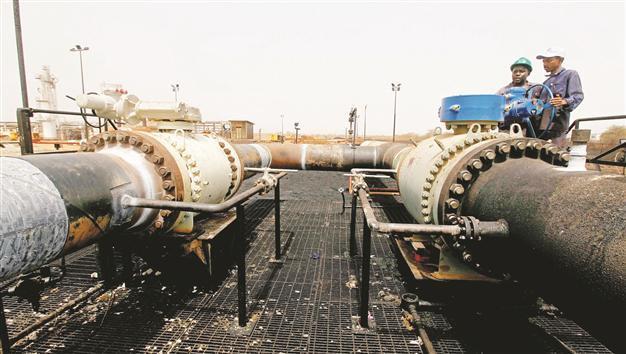East Africa on world energy map
JOHANNESBURG - Agence France-Presse

Sudanese repair crew work at the Heglig oil facility, after Sudan started pumping oil again from the war-damaged oil field in May. The reserves at East Africa’s coastal region might be 50 percent above those in Saude Arabia. AFP photo
Massive offshore gas discoveries in East Africa are catapulting the region into a major player in the global energy arena, bringing billions in investment that could transform entire economies.Off the pristine beaches of Africa’s Indian Ocean coast, multinationals have struck gas -- well upon well upon well. Planned investments worth tens of billions exceed the gross domestic products of some host countries, which range from regional power Kenya to impoverished Mozambique.
East Africa’s coastal region, stretching out to Seychelles holds 12.5 trillion cubic meters of natural gas, according to the U.S. Geological Survey. That’s about 50 percent more than in Saudi Arabia. “The gas discoveries offshore in Mozambique and Tanzania are large and world-class, with potential for more to come, including prospects for an oil leg,” said Duncan Clarke, CEO of oil consulting company Global Pacific.
“These finds will lead to LNG (liquefied natural gas) plants ... and will make the zone akin to the Northwest Shelf in Australia,” which can produce 23 billion cubic meters a year, he told AFP.
Houston-based Anadarko in June announced new finds in northern Mozambique which brought its estimated recoverable resources to up to 1.7 trillion cubic meters.
The company has proposed $15 billion in investments to set up LNG facilities. Mozambique’s GDP last year was $12 billion. Thailand’s PTT Exploration and Production in May announced a $1.9-billion deal to buy Cove Energy, whose 8.5-percent stake in the Mozambican fields is currently up for sale.
Two weeks earlier Italy’s ENI, the other large operator in the country’s Rovuma basin, said recent discoveries boosted its recoverable resources up to 1.5 trillion cubic meter.
“It will bring a huge flow of foreign direct investment in the region that would contribute to rapid economic growth in the region,” said Silas Olang, east African coordinator from resources watchdog Revenue Watch Institute. Mozambique expects that within five years, the new industry will account for 13 percent of the economy, already one of the fastest-growing in the world at seven percent last year.
A number of hurdles stand between producers and their potential gas wealth. “There’s very limited infrastructure in place,” said Tim Dodson, vice president for exploration at Norway’s Statoil on the company website.
Statoil and Britain’s BG together have discovered around 453 billion cubic meters in Tanzania.
Bad contracts
Mozambique’s Pemba is a good example. The closest city for offshore drillers, it’s 3,000 kilometers north of the capital Maputo. Completely caught off-guard by its mineral wealth, the country also lacks the skilled workforce to set up industries, with only 50 mining graduates a year. Both Mozambique and Tanzania have had to scurry to update petroleum legislation with the new industries. Governments have also come under fire for signing opaque contracts for capital-intensive mega-projects that don’t create many local jobs.
Questions remain how locals will benefit from the multi-billion-dollar industries. While Mozambique is booming, last year its economy created only $400 per person. Corruption is a “big challenge”, said Olang. With production only planned for five years from now, the effect may also take longer than people think, he said.
















